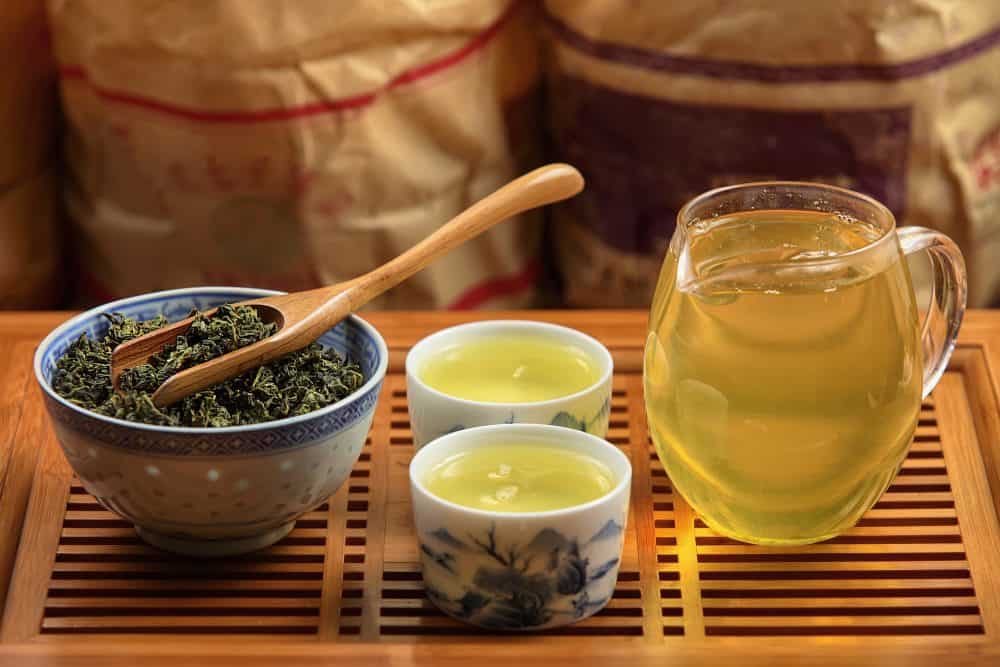
If you’ve been drinking high-quality teas for very long, then you probably appreciate that leaf selection is critically important to tea makers.
For instance, the best black and green teas are usually made from plant material at the tip of a leafy shoot. The tips of the tea plant Camellia sinensis constitute the famous “two-leaves-and-a-bud” and where caffeine, polyphenols, and many flavor-enhancing amino acids are most concentrated.
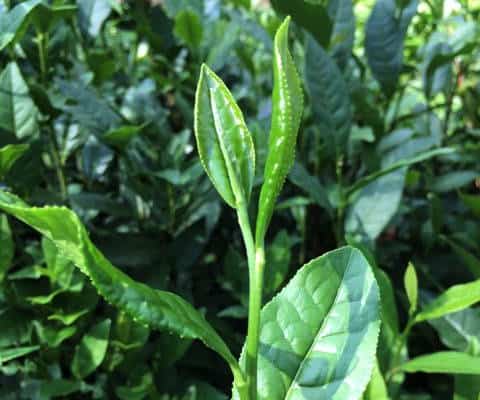
It is not widely appreciated, however, that makers of the oolong tea have a preference for a different leaf type. Many of the best oolong teas are made from a leaf shoot that has a small, semi-dormant leaf bud at the tip and an adjacent pair of elongate, mature leaves.
This particular leaf-bud combination, known as banji leaf in the tea industry, is favored by oolong producers for at least two reasons.
First, the sturdy little bud and the tough partner leaves can endure the elaborate physical manipulation required to make oolong tea.
Second, because banji leaf is fully mature, tea makers have access to compounds that are not as prevalent in the developing tips.
One such compound is an ingredient of essential oils called nerolidol. This terpene alcohol gives the best oolong teas their aromatic, airy quality and also contribute to flavors that range from grassy to fruity.
Nerolidol also lends to a mouthfeel in oolong that falls in the complex space between brisk and milky.
A signature feature of oolongs is, therefore, the incredible range of flavor and texture profiles that can be conjured out of banji leaves.
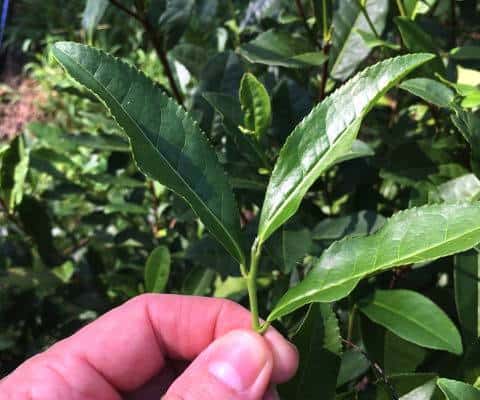
Oolong Tea Review: Where to Buy the Best Oolong Teas
In this post, I briefly describe the process of manufacturing oolong tea and expand on the unique features of this tea. I then review and recommend a selection of oolongs that I think you will appreciate.
I surveyed the best oolong tea brands that have excellent value in the following categories:
If you’re pressed for time, jump ahead to the tea reviews listed in the table of contents.
Table of Contents
- Oolong Tea Review: Where to Buy the Best Oolong Teas
- What Is Oolong Tea?
- Is oolong a black or green tea?
- How much caffeine does oolong tea have in it?
- Summary: Benefits of Oolong Tea
- Where to buy the best oolong tea: Our recommendations
- #1. Best Taiwan Oolong Tea: Alishan High Mountain Oolong
- #2. Best Bargain Oolong: Prince of Peace Organic Oolong
- #3. Best Daily Oolong: Davidson’s Quilan Organic Oolong
- #4. Best Tie Guan Yin Oolong Tea by Oriarm Tea
- #5. Best Milk Oolong: Republic of Tea Milk Oolong
- How to make oolong tea
- Putting it together: how to get the most out of the best oolong tea brands
What Is Oolong Tea?
Oolong refers as much to a method of tea processing as to a profile of tea flavor and mouthfeel. Though the details will vary according to the goals of a tea maker, oolong teas are generally made by following an elaborate series of procedures that can be modified to achieve a desired style of oolong.
The steps in making oolong tea
- Harvest of tea leaf. Though not all oolongs are made from banji leaf, proper seasonal timing of harvest is key to plucking leaf in the correct stage of development.
- Sun wither. Exposure of leaf to sunlight stabilizes nerolidol which imparts a bright, floral quality to oolongs.
- Tumble or toss. Withered leaf must be lightly bruised so leaf cells become “leaky” and plant phytochemicals can mix. Nerolidol is expressed as a result of leaf bruising.
- Oxidation. Polyphenols within plant tissues react with enzymes, water, and oxygen. The duration of oxidation is hugely important to oolong flavor and mouthfeel.
- Heating. At the tea maker’s discretion, exposure to low heat in either a pan or oven enhances the rate of oxidation, while a high heat will stop it altogether.
- Rolling. Now partially oxidized leaf must be pressure-rolled by hand or by machine so that flavor compounds are expressed onto the leaf surface.
- Compression. The rolled leaf is next packed into a fabric bag that is twisted and compressed by a machine. The leaf is eventually shaped into either a compressed spiral twist or balled up into a pea-sized pellet.
- Drying. Tea leaf is evaporated under heat so that textures and shapes are maintained. Drying also enhances long-term storage.
- Roasting. This optional step adds depth and body to the oolong flavor and mouthfeel. Hot charcoal embers are used in traditional methods of roasting.
That’s a lot of steps to making oolong tea. Compared to the simple procedures involved in making white teas, oolongs are among the most challenging of teas to manufacture. And to add a signature character to an oolong, the tea maker can alter each of the processing steps in subtle ways.
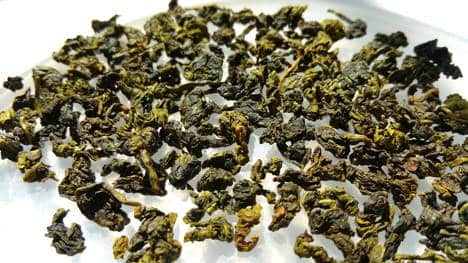
Finally, if you include diversity in tea plant cultivars used by different tea farms, or consider the major differences between tea-growing regions (e.g., China oolong vs Taiwan oolong), there is an incredible depth and breadth of oolongs to sample.
Is oolong a black or green tea?
One remarkable feature of oolong teas is that they are similar to green teas and black teas, but not quite the same. For example, tumbled tea leaves that are allowed a short period of oxidation—perhaps less than an hour total— are similar to green teas that have a fresh, grassy flavor.
In contrast, tumbled leaves that oxidize for longer durations tend towards a black tea with full body and nutty or earthy notes.
Between those two extremes of tea types lies a region of oolong flavor-space that reveals fruity, floral, orchid tastes that really excite the tea drinker’s palate.
How much caffeine does oolong tea have in it?
All teas made from Camellia sinensis naturally contain caffeine. The function of caffeine is to defend the plant against insect herbivores.
However, methods of tea manufacture can have a dramatic impact on the amount of caffeine that is available in your morning cuppa. For instance, tea made from tippy leaves generally has the most caffeine because tips are more vulnerable to insect attack and, therefore, require high levels of chemical compounds for self-defense.
But banji leaf used for oolong is not like the tips. Banji is structurally tougher and lacks altogether a tender leaf bud that might attract insects. Therefore banji can defend itself with relatively less caffeine.
You, as the tea drinker, will consume less caffeine per cup of oolong than you will in green or black teas. Perhaps as low as 37 mg of caffeine, on average, per serving of oolong compared to matcha tea and some black teas which have, on average, about 85 mg of caffeine each.
That’s pretty a significant difference if you’re caffeine-sensitive or if you just want to sleep after your evening tea.
Summary: Benefits of Oolong Tea
There are different reasons for drinking oolong tea, depending on your preferences. The benefits of drinking oolong may include:
- A range of flavors for all tastes: tea makers change the flavor profiles by adjusting oxidation levels, cooking temperatures, and the extent of physical manipulation of the tea leaf.
- Reduce caffeine intake: oolong has less caffeine than most camellia teas and all coffees.
- Good for many infusions: rolled leaf unravels gradually with each infusion, revealing new flavors each time.
- Less bitterness than black tea: flavors are more floral and fruity than astringent and bitter.
Where to buy the best oolong tea: Our recommendations
To compile these reviews I studied dozens of tea brands and hundreds of online comments of tea drinkers. The process of aggregating reviews is challenging to say the least. But in the end, I came up with several brands that I think you should consider trying.
I indicate in the reviews if I have personally sampled a particular tea, and include my impressions therein.
In order to make the cut, a tea brand had to satisfy all the following criteria:
If you’re new to oolong teas, it’s probably a good idea to try several different styles. This way you can experience the remarkable range of character of oolongs. I am sure that you’ll find at least one style that suits you.
Let’s get started with our recommended oolong tea brands!
#1. Best Taiwan Oolong Tea: Alishan High Mountain Oolong
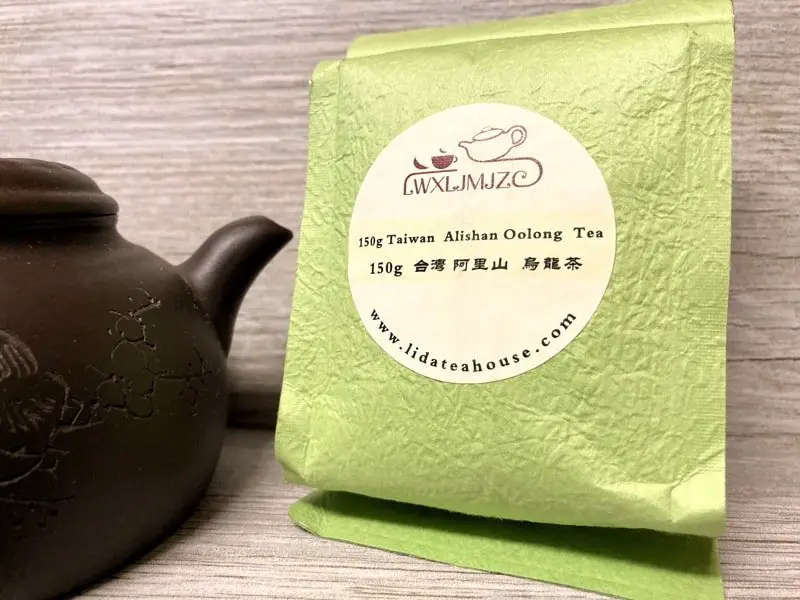
China may be the birthplace of oolong-style tea but it didn’t take long for oolong technology to transfer abroad. By the 1990s, Taiwan had become a significant player in the global oolong market, and for good reason.
The island of Taiwan is blessed with ecologically diverse tea-growing regions that encompass rolling lowland hills and stunning mountain ranges as high as 8000 feet (2400 meters). Among the more famous tea mountains is the Alishan Range which forms part of the spine of the island. Scattered along the gradients in altitude are found tranquil tea farms, many of which specialize in growing Camellia sinensis solely for oolong teas.
There are several compelling benefits of growing tea in high mountains. These benefits include:
- Less exposure to pollutants. High mountains are often isolated from industrial development and busy highways which can be sources of pollution.
- Gentle sunlight. Mountain mists and clouds in the Alishans filter out harsh sunlight that might impart bitterness and strength in tea.
- Slower tea growth. Cool summer nights and occasional winter snowfall slows plant growth and enhances flavor-giving polyphenols and amino acids.
- Less need for insect control. Shorter and colder growing seasons at altitude reduces insect populations which in turn reduces the need for pesticides.
Unique growing conditions such as these give Taiwan high mountain teas a signature flavor profile. In general, oolong from the Alishan Range tends to have a sour-apple candy note with a bright and breezy freshness that has the essence of cool mountain air. Teas from Alishan are sometimes called the “Champagne of teas” not just because of their excellent flavor and mouthfeel, but also because of the yellow-amber color of the tea “liquor,” the part you drink.
My sample of Taiwan Alishan oolong is from the LWXLJMJZC tea merchant. No, that’s not a misprint, and yes, the company name is weird. But who cares? In my tasting of this tea, I experienced the much-anticipated sour candies but also a subtle grassiness without the thick, umami mouthfeel that you might experience with a Japanese green tea. Instead, there is a mouthfeel of lightly roasted almond nuts.
I also agree with the online tea reviews that identified a floral perfume in this mountain oolong. It’s not a blast of fragrance like you would get from a bouquet of roses, but rather a gentle expression of wild azalea growing on the edge of an inviting forest.
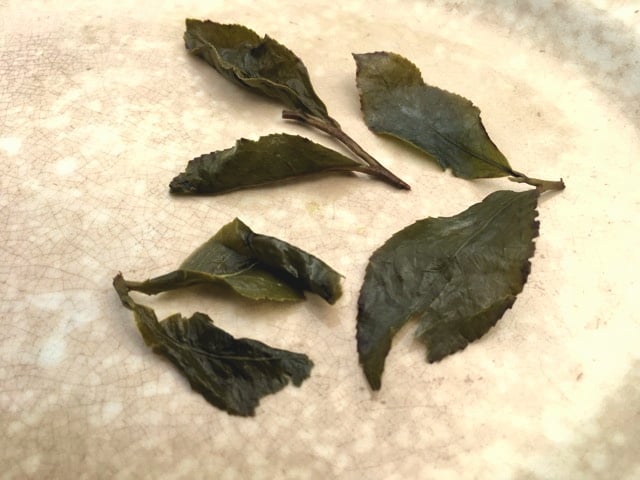
Putting together each of the understated elements of sour candies, grassiness, roasted almonds, and azalea, you have a delightful tea that will leave you wanting another cup. And cupfuls you can have because the LWXLJMJZC oolong is good for many infusions. Just keep each infusion short and you can stretch out the same leaves to several cups.
#2. Best Bargain Oolong: Prince of Peace Organic Oolong
I am not a tea snob. I appreciate that there are times when a no-frills, no-fuss, easy-to-use bagged tea is the best choice considering your budgetary constraints and personal tastes.
But come on. Most of what passes for tea in those bags is not much better than the dirt that grew the tea. And there’s no telling what agrochemicals have been applied to that dirt!
The solution to the bagged-tea dilemma is to go with an established brand. In addition, look for a brand that has made some effort to verify that farming practices do not include pesticides or herbicides. Go with a certified organically grown tea.
The Prince of Peace Company (or just POP) has been making people happy for years with their budget-friendly offerings, including a gentle oolong tea that is packed in simple, unbleached tea bags.
Reviewers applaud the consistent quality standards maintained by the company over many years of operation. They also appreciate that USDA organic certification has been applied to POP’s oolong.
Tea reviewers describe this oolong as light and floral but with body emerges from a brief oven roast given to the leaf. Tea drinkers who are caffeine sensitive also report that POP’s oolong has low levels of this stimulant, which is consistent with the company’s claim of 30 mg per 8 oz cup, on average.
I like having in my cupboard a ready-to-use bagged tea for when I’m short on time. For my money, I think that the Prince of Peace brand oolong tea is the way to go.
#3. Best Daily Oolong: Davidson’s Quilan Organic Oolong
In the preceding section, I recommended a best-bargain oolong tea and here I’m reviewing the best daily oolong. What’s the difference?
In a word: quality. Or to be technical, a good daily is more better than bargain tea.
I stress, again, that not all bagged tea is poor, it’s just that it could be better than it usually is. The Prince of Peace brand that I discussed above is the tea-bag exception, not the rule.
In addition to being above average, a good daily oolong should also be multi-use. For example, another use of oolong tea is for kombucha ferments or chai spicey tea mix. That is why I have settled upon a daily tea that is not just more better and affordable, but also useful for a variety of tea needs.
Davidson’s Tea Co. sources teas from around the world and has the skinny on what’s hot and what’s not. They know how to meet the demand for an excellent value in bulk-shipped teas, and I have been quite pleased with their other specialty teas.
Davidson’s distributes from China a certified organic, lightly roasted oolong tea that reviewers describe as smooth and with a nuttiness that balances a delicate floral note. Quilan (or Qilan) means “rare orchid” in Chinese and accounts for the floral profile of this oolong.
Reviewers also say that Davidson’s oolong supports a robust SCOBY and yet doesn’t overpower the brew. However, to hit the fermentation sweet spot you may have to experiment with the quantity of infused tea. The option of a 1 US pound packets gives you just that flexibility to experiment.
Add to these benefits a very agreeable price point and you have yourself a great daily oolong!
#4. Best Tie Guan Yin Oolong Tea by Oriarm Tea
One of China’s most famous teas is Tie Guan Yin oolong or Iron Goddess of Mercy oolong. In China, Tie Guan Yin, or simply TGY, is often exchanged among friends as a symbol of goodwill and hope for the future.
In my experience, TGY was the first gratifyingly mind-blowing oolong tea that I had yet tasted. More still, TGY was to become a gate-way tea that seduced me down the path of ever more compelling and challenging teas.
How is Tie Guan Yin made?
The English spelling is sometimes different—tea kwan yin is a common misspelling—but most tea aficionados know what you’re talking about: a splendidly floral tea with top notes of fruit, zest, and perhaps sour candy. All of which is often balanced with a light roasting that lifts the body and holds the flavors a bit longer on the palate.
Tea makers evoke the amazing TGY flavor profile in two ways. First, they often use a particular tea plant cultivar—the tie guan yin cultivar, of course—with its own special combination of polyphenols, antioxidants, and other phytonutrients.
Second, tea makers use short periods of oxidation to extract the floral-fruity slice of the TGY profile. In other words, the harvested leaf is processed somewhat like green tea with an emphasis on preserving vegetal qualities that may be lost under longer durations of oxidation.
The partially oxidized leaf is then exposed to machine-assisted, twisting-compression alternated with low-temperature bouts of heating. Several cycles of twisting and heating may be used to bring forth the richness of flavor and mouthfeel.
And finally, the tea maker may roast the leaf at low temperature to elicit even more tea body.
Where to buy the best Tie Guan Yin oolong
Each of these characters comes together in a TGY that I recommend here today. This oolong is distributed by the China-based Oriarm Tea Company which works with local farmers to find and process the best leaf.
Oriarm’s TGY is sourced solely from the famous Anxi tea district in Fujian Province. Here the altitude is up to 3200 feet (1000 meters), which to Oriarm is “high mountain” but nothing like the Alishan Mountains. Close enough anyway, and what matters is the high spirit of the tea farmers!
This particular oolong has what the company describes as a “clean aroma,” which means that the tea is lightly oxidized and hence more towards the green-tea end of the flavor spectrum.
Tea reviewers don’t use exactly the same descriptive terminology as Oriarm, but, again, the spirit is the same. They rave about this TGY’s orchid-flower top notes and the lingering but gentle mineral finish.
Reviewers are also happy with what a great bargain this tea represents. The minimum purchase is about 3.5 ounces (100 grams), which may not seem like a lot of tea until you consider the very reasonable price point.
To make things even more attractive, reviewers also report that each batch of tea is good for many infusions. Now that’s real savings!
#5. Best Milk Oolong: Republic of Tea Milk Oolong
There are two kinds of milk oolong teas: those that have a milk-based additive or “natural flavoring,” and those that do not. Genuine milk oolong has nothing added except for the magic of the tea maker who coaxes out of the leaf a smooth and silky yet full and lingering mouthfeel that is similar to the sensation of drinking cow’s milk or cream.
So don’t worry if you’re lactose-intolerant, your tummy will be fine with a true milk oolong.
More than fine, actually. Just steer clear of those teas with additives, which should be indicated on the label. If not, use your nose. An oolong “enhanced” with milk product will usually have a very strong milky aroma while the aroma of an unadulterated oolong will be mellow and only hint of milk essence.
Where to find the best milk oolong
The trouble, however, is that the market is overwhelmed with milk-enhanced oolongs. A tea drinker has to look pretty hard and do their research to find a true milk oolong these days.
But the tea hounds here at Leaf House Tea have sniffed one out for you!
The Republic of Tea brand has procured a tea from Fujian, China that does what a good milk oolong should. On the one hand, say reviewers, the tea has the smooth texture of cream while on the other it has fruity notes suggestive of pineapple and a floral loft that hints of orchid.
And not to worry about the lactose: Republic’s milk oolong is pure leaf. It contains no additives and has been certified both gluten-free and Kosher.
Holding such a strong flavor profile is quite an achievement for any leaf, and especially so for a bagged tea. Reviewers love the convenience of the bag, and many report that Republic’s milk oolong is their go-to tea for travel and the office where there’s no time to fuss with loose leaf tea.
The product is available in a small, attractive tin that is handy for transport and makes a great gift tea. Larger volumes of bags are available for those with a big appetite for a wonderful oolong.
How to make oolong tea
Just because oolong tea has a complex character doesn’t mean that it’s difficult to brew up a fine cup. Indeed, in my experience, oolongs are some of the simplest teas to brew properly, but it does help if you keep in mind some basic principles of tea preparation.
Best water temperature for oolong tea: be cool!
It is generally true that teas in the middle-range or higher in quality are sensitive to water temperature. In particular, water that is at a full boil—212°F—will nearly always elicit astringency or bitterness in both flavor and mouthfeel. Not everyone likes these qualities in their tea, which is why I recommend that when you brew an unfamiliar oolong tea you should use water heated in the range of 190 to 205°F. That’s a lot of latitude in temperature so try both the upper and lower end of this range and see what difference it makes in your oolong tea experience. From this starting point, you can experiment with ever-higher (or lower) temperatures until you find a range that suits your tastes.
How much oolong tea to use?
To bring out depth and strength in tea, steep more tea per given volume of water. Conversely, to evoke a milder tea, steep less leaf. This sounds like an obvious principle; however, most inexperienced tea drinkers will try to make oolong tea taste better by letting the tea steep for longer durations rather than steeping more tea leaf per serving. But as with high-temperature water, an extended steep will tend to bring out a bitter-tasting aspect of most tea. Instead, adjust the quantity of leaf in order to adjust the depth of flavor.
To apply this principle to a new tea, try the following. Use one heaping teaspoon of whole-leaf oolong tea per 6 ounces of water for each tea drinker. (Note: this doesn’t apply so much to bagged tea where the quantity is already allotted). If you find that you want richer, fuller, and deeper oolong flavors, then increase the quantity of tea leaf by 50 percent (e.g., one-half a teaspoon) in your next tea session. If adding more leaf doesn’t change the flavor then you’re probably drinking a low-quality tea. A good tea will definitely respond to a change in the quantity of leaf.
How long do you steep oolong tea?
I just mentioned the hazards of steeping too long, but consider this trade-off: the longer you steep the tea leaf the fewer total cups of tea you’ll get from a batch. On the extreme end, steeping your oolong for, say, a ten-minute stretch may extract all of the flavor compounds from the leaf, but you may only get one cup out of the batch (and it may be oversteeped and awful). On the other end, one-minute of steeping may give you many separate cups but each one may lack oolong spirit.
What to do?
With your new oolong, try a medium-length steep of about two-and-a-half minutes. If you’re pleased with the first cup, then add another 30 to 60 seconds to the second steeping, and so on for the subsequent steepings. Repeat until you run out of oolong goodness.
However, if you discover that your first cup of oolong has too much sharpness or mineral mouthfeel, remember for your next tea session to cut back the steep time by about 30 seconds. A shorter time should take some of the sharpness out of the tea.
Putting it together: how to get the most out of the best oolong tea brands
I just covered the three factors of tea making that you can control: water temperature, the quantity of leaf, and duration of steeping. Putting it all together, try this combination the next time your sample a whole-leaf oolong tea:
And now, enjoy one of the finest tea sensations that humankind has ever produced: oolong tea.
Mike grows and crafts tea in North Florida, USA. He has advanced degrees in biology, and has undertaken coursework in manufacturing Camellia sinensis teas. Mike is a member of the US League of Tea Growers (USLTG) and has presented invited talks on tea growing. Send him a note through our Contact Page if you'd like to talk about tea.



